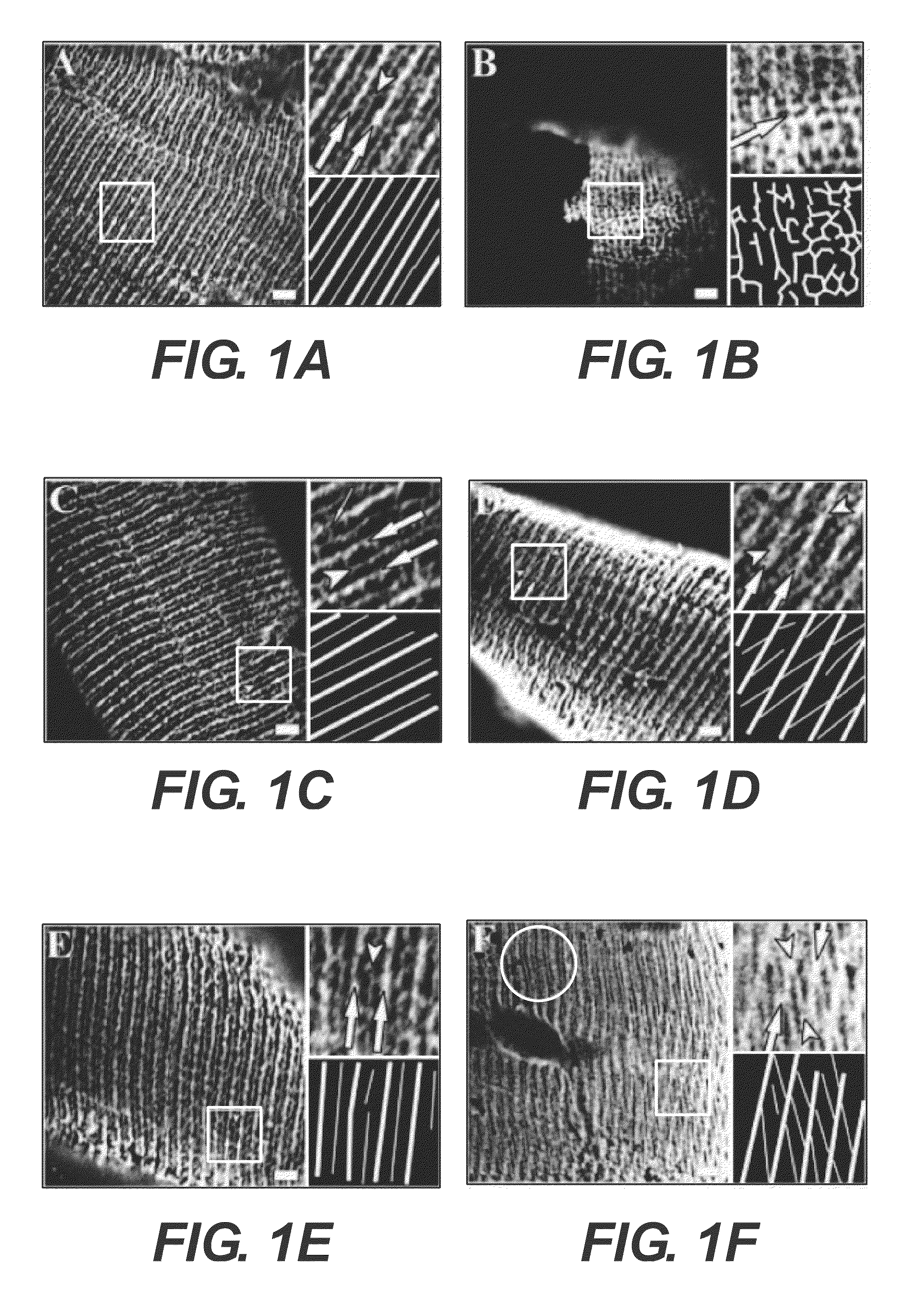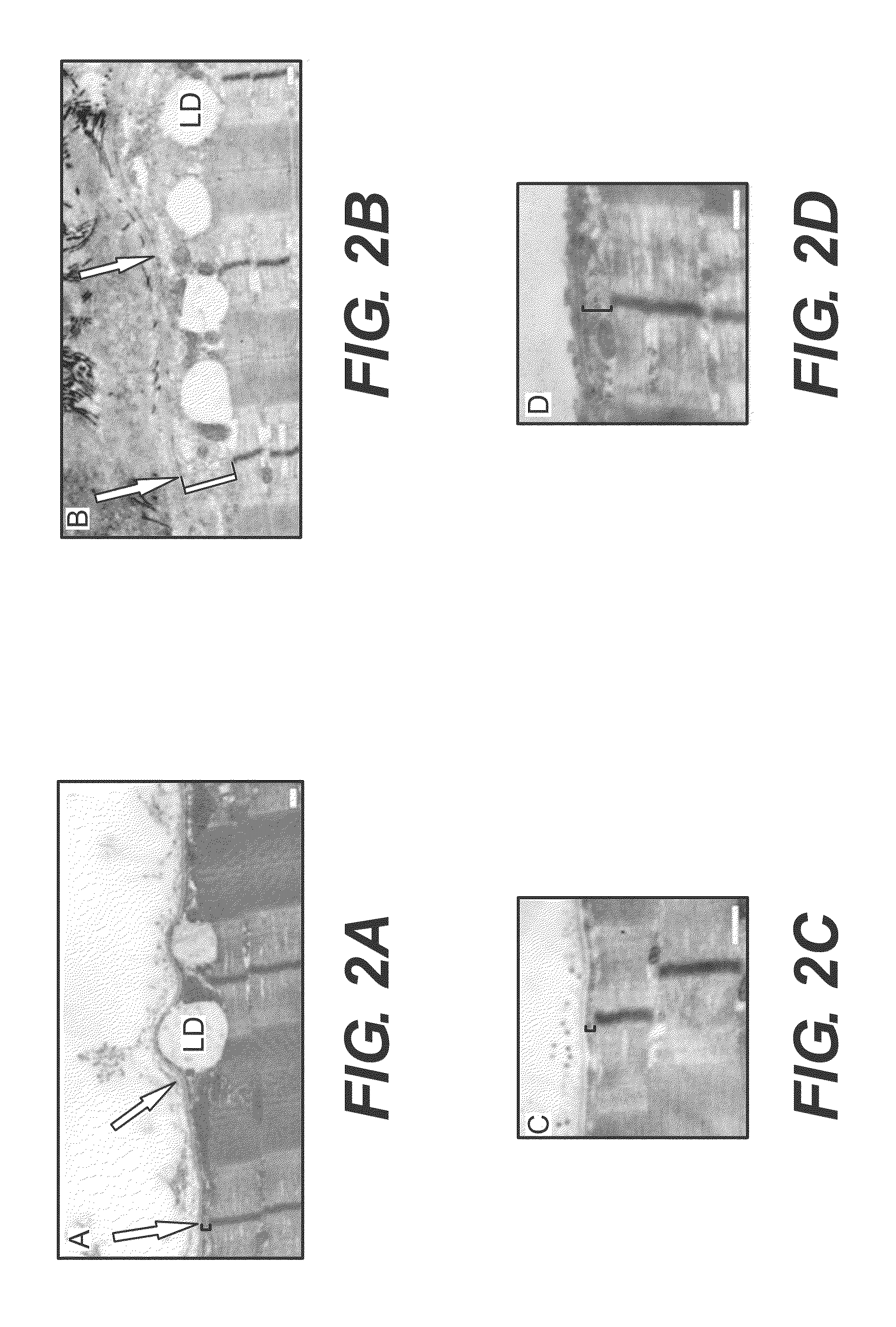Methods of diagnosis and prognosis for a muscular dystrophy
a muscular dystrophy and muscle technology, applied in the field of muscle dystrophy or myopathy, can solve the problems of muscle weakness, muscle loss, and inability to fully understand the mechanisms leading to muscle weakness and ultimately to muscle loss, and achieve the effect of decreasing or inhibiting the biological activity of mu-crystallin
- Summary
- Abstract
- Description
- Claims
- Application Information
AI Technical Summary
Benefits of technology
Problems solved by technology
Method used
Image
Examples
example 1
Changes in Organization of the Sarcolemma in FSHD
[0081]Methods were developed and used to examine longitudinal sections of unfixed human muscle biopsies, followed by immunofluorescent labeling of sarcolemmal proteins, to determine the organization of the sarcolemma and the subsarcolemmal membrane cytoskeleton in FSHD patient. Normally, the sarcolemma is organized into regular, transversely oriented membrane domains that overlie the Z-disks and M-bands of the superficial myofibrils. These structures have been called “costameres,” because of their “rib-like” appearance along the surface of each muscle fiber (Cell Motil. 1983: 3:449-462). Costameres are linked to nearby myofibrils at Z-disks and M-lines by at least 3 different kinds of cytoplasmic filaments, actin microfilaments, desmin-based intermediate filaments, and keratin-based intermediate filaments (Exerc Sport Sci Rev. 2003; 31:73-78; Clin Orthop Relat Res. 2002;S203-S210). They help to organize and stabilize the sarcolemma, h...
example 2
Protein Analysis FSHD
[0083]The present inventors examined proteomic changes associated with FSHD by studying open biopsies of, for example, deltoid muscles from FSHD and histologically normal control patients (FIG. 3). In an exemplary method, the biopsy samples were clamped at resting length, snap-frozen in isopentane, cooled with dry ice, and stored at −80° C. Soluble proteins were extracted from muscle biopsies as described. Two-dimensional electrophoresis (2DE) and silver staining were performed as described using 40 cm tube gels in the first dimension and two 20×20 cm2, 10% acrylamide slab gels, with some modifications (P. W. Reed and R. J. Bloch, manuscript in preparation) (Methods Mol. Biol. 112, 67-85; Methods Mol. Biol. 112, 147-172). Some of the modifications include, for example, (i) the use of 2 M thiourea, 7 M urea, instead of 9M urea, to dissolve samples prior to isoelectric focusing (IEF), to improve solubilization and inhibit proteases; (ii) the use of a strong reduci...
example 3
Mu-Crystallin and Other Muscular Dystrophies
[0086]Immunoblots of soluble fractions prepared from biopsies of deltoid or quadriceps muscles of patients diagnosed with inflammatory myopathies, including dermatomyositis (deltoid) and, polymyositis (deltoid), and muscular dystrophies, including limb girdle muscular dystrophies types 2B and 2I (quadriceps), and Duchenne muscular dystrophy (quadriceps), showed no increases in mu-crystallin compared to controls (FIG. 4). However, the lack of increases in mu-crystallin found in these samples does not foreclose the possibilities that mu-crystallin is indeed upregulated in these other muscular dystrophies and myopathies. Without being bound by theory, the inventors of the present invention hold that based on mu-crystallin's upregulation in FSHD, and in vivo studies (discussed below), supports its role as a potential therapeutic, diagnostic, or prognostic for other muscular dystrophies and myopathies of the instant invention. For example, the ...
PUM
| Property | Measurement | Unit |
|---|---|---|
| gap size | aaaaa | aaaaa |
| pH | aaaaa | aaaaa |
| apparent molecular mass | aaaaa | aaaaa |
Abstract
Description
Claims
Application Information
 Login to View More
Login to View More - R&D
- Intellectual Property
- Life Sciences
- Materials
- Tech Scout
- Unparalleled Data Quality
- Higher Quality Content
- 60% Fewer Hallucinations
Browse by: Latest US Patents, China's latest patents, Technical Efficacy Thesaurus, Application Domain, Technology Topic, Popular Technical Reports.
© 2025 PatSnap. All rights reserved.Legal|Privacy policy|Modern Slavery Act Transparency Statement|Sitemap|About US| Contact US: help@patsnap.com



